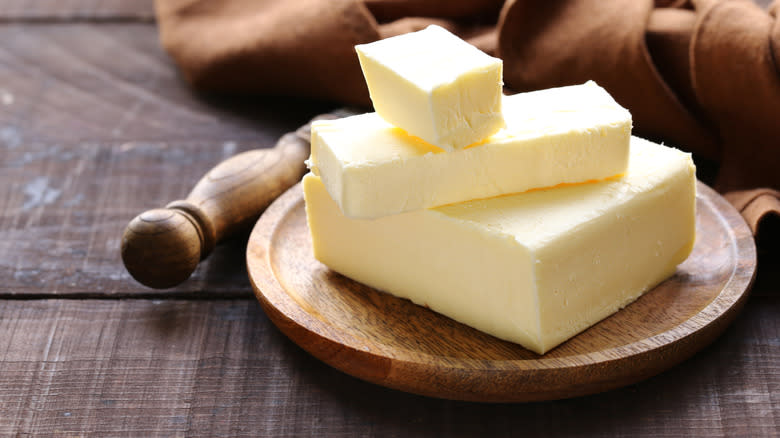You Can Actually Taste The Difference Between Regular And Grass-Fed Butter

Butter is one of the essential groceries that you can find in most people's fridges. Although it's a relatively simple product, you might be surprised by the dramatic differences in taste, texture, and appearance when comparing two sticks of butter made from different milk sources. A prime example of this is the contrast between the standard butter found in most grocery stores and the butter made from milk produced by grass-fed cows.
Grass-fed butter, as the name suggests, comes from cows that grazed on grass. In contrast, regular butter is made from milk produced by cows that are typically fed grains. A grass-only diet for the cow leads to butter with a creamier consistency and a richer, more unique flavor. So unique, in fact, that you can taste the difference. When you try grass-fed butter, you'll find subtle herbal notes that clearly set it apart from regular butter, which tastes more like whole milk with a hint of maltiness. Some even describe it as having hints of fresh green vegetables!
So, whether you're baking with it or using it for your white wine sauteed mushrooms, you can count on grass-fed butter to give your palate a nice, flavorful surprise. Beyond taste, you can also distinguish these two types of butter by their colors. Regular butter is milky white, while grass-fed butter is yellow thanks to its higher beta-carotene content — the same compound that gives carrots their orange color.
Read more: The 20 Best Olive Oils For Cooking
Are There Any Health Benefits To Choosing Grass-Fed Butter?

There are plenty of health benefits to grass-fed butter over standard butter! Not only does it offer more complex flavors but it also comes with a hefty dose of vitamins and minerals. The rich beta-carotene that gives grass-fed butter its color is also a precursor of Vitamin A, which is essential for keeping your eyes healthy. Additionally, it's a good source of calcium and phosphorus, which are excellent for your bones.
Grass-fed butter is plentiful in unsaturated fats, especially omega-3 fatty acids. The National Institutes of Health note that Omega-3s play a key role in your health by maintaining your cells, providing energy, and boosting your immune system. Plus, they might help shield you from heart disease. Another beneficial fat in grass-fed butter is conjugated linoleic acid (CLA), which has a potential link to reducing the risk of heart diseases, as per a study in the Journal of the American Heart Association.
However, it's important to keep in mind that grass-fed butter still contains a significant amount of saturated fat, which should only be consumed in moderation. If you're looking to build a heart-healthy diet, the Mayo Clinic suggests incorporating more olive oil (which is richer in helpful monounsaturated fats) into your diet rather than relying heavily on butter, whether grass-fed or not.
Read the original article on Tasting Table.

